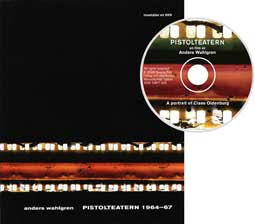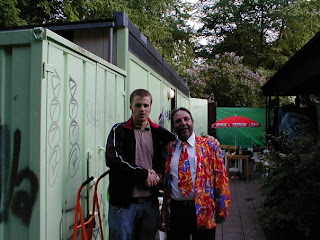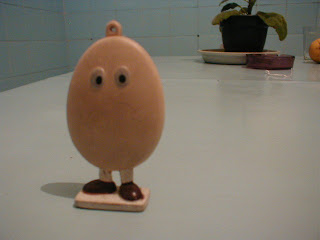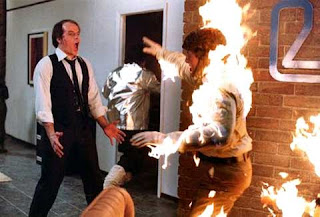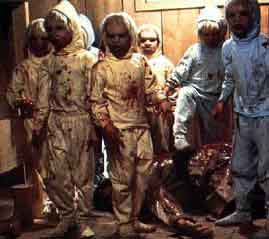“Out of bed early. Went to the window, like every morning. I’m asking the world, or at least this place, with this morning ritual.”
Some works continue, refreshingly undisguised, into Johan Jönson’s books of “poetry”; some jargon from Heiner Müller, some drug-and-sex-metaphysics from Burroughs, and some concepts from Deleuze, Virilio, and others. However, it is also possible to absorb him as death metal, grindcore, Skinny Puppy, Meshuggah, Autechre, Merzbow. That is probably the interpretation that will get you the closest to these books.
The two years from Johan Jönsons debut Som Samplingsdikter (“As Sample Poems“) to Näst sista våldet (“The Next To Last Violence“) are important. The form has been straightened up – each spread is four lines, an empty line, another four lines, and the same thing on the other page, which is a contrast to the debut’s rambling, lightly edited first person monologues. The subject-matter also finds itself more concentrated. The undertitle Stycken ur anställningen (“Pieces from the employment“) hints at a movement away from the autobiographical to stark images of work in hospitals, laboratories, apartment buildings, subways, civil war, insect-consciousness. The text has become more naked, open, without hope – and fertile. We can continue here.
Much of the bleeding heart anarchist-sentiments that always could be found in the earlier books have been sweated away when we come to I krigsmaskinen (“In The War Machine“) – even though the tendency to research and analyze the planet remains. Something could be said here about writers who take efforts to create other stories than those from their own short life, who write themselves out of their own shitty angst and self-absorption (what Swedish poet-turned-aphorist Vilhelm Ekelund called “lyrical ‘unhappiness’ -: cowardice, a feminine bluntness in reasoning-tools, feminine self-pity, lack of interest in the truth“.
I read MONOMTRL as “one material” – a mass where everything affects everything, everything is needed (an outgrowth on the Spinoza-Deleuze-branch) – but also “materialistic”; all noise is needed, all the dirt, all distortion, all the patient, waiting, trying, testing, experimental work. Here it means descriptions of cities, blurry monologues, over-edited samples, noise, work-place-reports, distortion, repetition, in an unstructured composition; an open system, a continuing work.
“WHAT MEANS SOMETHING?
Unresolvable oppositions.
Other people’s suffering.
Sex-less blow jobs.
Short stories about God.”
Here follows some excerpts from MONOMTRL, translated into english.
***
9
Vibrations woke me up in the middle of the night. Had dreamt about death as a well-doer. An infinite number of nurses in white that floated forth and gave deadly and painless injections to everyone who preferred to be dead, but were afraid of the process of dying itself. Before the injections the nurses fulfilled everyone’s last sexual desires.
***
OPEN FIELDS
… an open space in different grays … between … the cast concrete-foundations that … gives support to the city-states streets and squares … an annihilating light … on its way forward … entering …
-
… a parking place … thrown out into space … outside of … the city is felt … in connection to … an incalculable shopping center … but … going away … or drowning … a dull electric ocean in an artificial green that … floats … a slow-flowing transparence … an interstellar gel … reflections of light … and subject the decorated shopping cart … that is about to speak …
-
… steppe-desert-landscape-sepia … insoluble with the sepia of the production … heaven and sand is blurred together … chopped-of cattle head … or buried cattle … close … in the feverish and very slow phenomenology … dusk and dawn … unidentified floating particles … dissolution between vision and experience … a deserted barn … mild hallucination about wide-spread death … and a possible newly awoken glitch … to restart from … to finish …
-
… glistening green corridor in movement … geometric waterfall of fluorescent lamps … a clinic and seducing vacuum-draft… right in front of … on the same level … nothing behind the mute and static light-flow …
***
IX
If we could see the networks of electricity, telephone- and computer-communication with our own eyes, we would see that matter has freed itself and has started thinking and that the earth is covered by an aura of diffuse light.
***
AN ARGONAUT MACHINE
1. Play. Cum. Noise. Through
2. me. Yes. Rectally. De
stroy. Play. Re
3. Make me. Stop. Wombs
pump. In
spurts out
4. 5. symptom-carriers. Silver dots. Directly
in the motor-wheelchairs. Rec. The Dollar Sign.
Rerewind. In the out
march of microbes. The front
asses constitutes a. Noise. Single. In.
6. 7. 9. A coordination system. One.
Mumbling. Wide open mechanical and.
8. Flat abyss. In. Silence. Still. All
directions. Play. The surviving.
Mumbling. Shit on the or
igin-machine. Give us
residence permits and. Fastforward.
Our daily. Blood sacrifice. I
give birth and kill. One
10. 11. 14. triangle. Becomes and
becomes. What you want. Pause.
Die. My body. A negative circle.
Are no longer. Use.
Noise. Flicker. Play. Here.
15. Chopped of body
parts. Of me.
16. 17. 29. Rec. Mirror-rectangular. I am made.
To that slave. Rerewind. Play.
I can constitute. If. Again. Bubbling
13. silver dots. I. Am re
territorialized. I.
The pentagon. On bare.
Knees. Stop. With gaping
eyes. And gaping
18. 20. 19. mouth. And. Noise.
Fastforward. Rerewind. Play.
24. Still. Rec. Mumbling. Chopped
up-bodily-ness. Here.
Scrawling. My Heart. Pause. But.
25. 26. 44. That is. Play.
29. 28. A technical. Artefact. Play. Pause.
Yes. But. That.
Fastforward. Rerewind. Still. Working.
For. Mumbling.
27. The girls. Noise.
Flicker. Silence.
Play.
23. Rec. About. Mani. Hackings.
31. Padme. Rec.
¥‡ºŠ™§. Hum. Mmmm.
